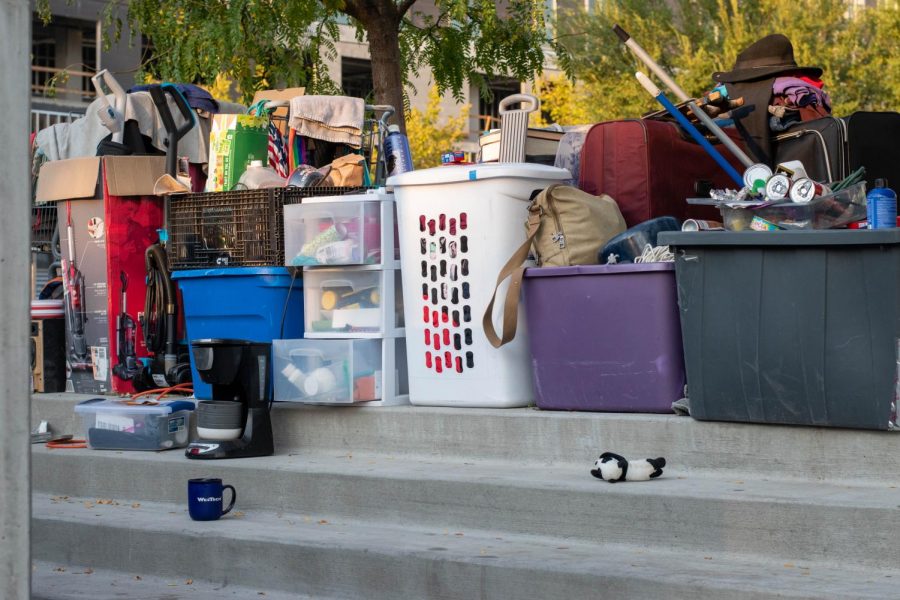Soter: Salt Lake Needs to Stop Camp Cleanups
Belongings of an individual experiencing homelessness in Salt Lake City, Utah on September 21st, 2020. (Photo by Gwen Christopherson | The Daily Utah Chronicle)
September 28, 2020
My parents’ house is close to the freeway, and in the last several months the homeless population that inhabits the viaduct beneath that exact freeway entrance has increased dramatically. While my parents are sympathetic to the homeless population, raising a family close to so many experiencing homelessness raises practical concerns as many are suffering from drug addiction or severe mental health issues. In fact, conversations about this problem are what inspired me to write this op-ed as my parents and their neighbors continue to be baffled by the increasing homeless population.
So, why is there all of a sudden such a dramatic and visible explosion in this struggling population? The problem I found was catalyzed by Salt Lake County’s COVID-19 winter plan. The plan is centered around intense camp cleanups — a band-aid fix on a gushing wound. Salt Lake County needs to stop camp abatements and replace them with an increase of services and spaces for the unhoused and vulnerable members of our community.
Salt Lake City was recently praised by major metropolises, like San Francisco, for our efficiency in handling the chronic homelessness crisis, but short-term homelessness has always been one of our city’s biggest problems. Last winter’s removal of Salt Lake City’s emergency downtown shelter, The Road Home, and its replacement with 3 much smaller shelters, proved we still had a long way to go. Since then, the COVID-19 pandemic struck, proving that many federal systems don’t have the infrastructure to maintain a thriving society in the midst of a crisis. Housing is one of those systems.
Many homeless people feel safer camping right now than checking into a shelter. Who can blame them? It is so hard to enforce social distancing within such close spaces. Especially, when they take into consideration how hard retirement homes and homeless shelters were hit at the beginning of the pandemic. The lack of health insurance and other access to healthcare also raises the risks and consequences of contracting COVID-19 for homeless people — putting many in between a rock and a hard place. Not to mention, most shelters have been functioning at or near capacity all summer. So, even if protection from the pandemic was not an issue, many would still not be able to get a warm bed in a safe shelter.
The increase in short-term homelessness is also correlated with the ensuing eviction crisis due to COVID-19. With many people laid off and no longer receiving stimulus checks from the government, paying rent is practically impossible, leaving renters further behind and creating new waves of ever-increasing homelessness.
Salt Lake City Mayor Erin Mendenhall’s COVID-19 winter plan is split up into five sections including health, education and child-care, operations and service from the city, economic support and homelessness. The mayor’s focus on homelessness in the plan resulted in the two-phase community commitment program meant to tackle the city’s homelessness crisis. The program is questionable at best and has caused much social upheaval and protest in the last several days.
The first phase of the program is defined as 12 weeks of “intensive” weekly camp cleanups. The intent of camp cleanups is to force those living on the streets to pack up all of their belongings they wish to keep and move to a different location so that local officials can clean debris. The problem with this response is that moving homeless camps to a different location does nothing but exacerbate the homelessness crisis. It only causes more pain, panic and chaos for those who are experiencing homelessness rather than getting them the help they need. In fact, the CDC recently released a report advising governments to not enact camp cleanups unless the city has other housing options available to those experiencing homelessness. Salt Lake has no other options put in place.
The second part of the Mayor’s community commitment program is to ensure that people living in camps will be met with social services if they so please. But this promise seems hollow and its delivery is inadequate. Just last week at one of the cleanups, a Fox 13 reporter spoke to a couple who was promised social services. They didn’t receive them.
Cleaning up one camp in one place means another will spring up nearby. This senseless migration only makes a desperate population more desperate. The county needs to emphasize its second phase — offering more resources — not the first. And, while Mendenhall’s intentions are in the right place, they are insufficient to address our city’s needs.









JoAnne • Oct 23, 2021 at 3:48 am
Hi I’m BabyJo, I’m one of the many Unsheltered out here in Salt Lake. I’m kinda the homeless homeless advocate. I am trying to also help our community. https://www.change.org/p/help-me-make-my-daughter-s-last-wish-cone-true-help-the-salt-lake-city-homeless-we-re-just-trying-to-survive-also?recruiter=17235802&recruited_by_id=b72cea00-cafc-012f-691c-4040acce234c&utm_source=share_petition&utm_medium=copylink&utm_campaign=petition_dashboard
Gregory Soter • Sep 29, 2020 at 5:49 pm
Another great article Theadora
You nailed it. We must find a way to get people permanent housing for those who need it. I hope the Mayor takes your in depth study seriously. There are many vacant buildings in the city that would be much more appropriate to house these people than in a crowded residential area like Sugarhouse.
I’m so proud of you and your writing abilities and your analytical abilities. What happened to the proposed low income housing being replaced by all these New luxury apartments.
Keep up the good work Theadora.
Mary Simos • Sep 29, 2020 at 5:39 pm
Such an important matter in our community. Thank you Theadora for addressing it. Your point about replacing the sq. Footage of the homeless shelter and the other shelter you mentioned in the city with 3 other shelters throughout the city is in my opion a scam of tax payers dollars. For instance the Sears building and many like properties would service the homeless with more services than the overcrowded areas such as Sugarhouse and the like. Hope the Mayor considers your insightful investigation of this important issue.